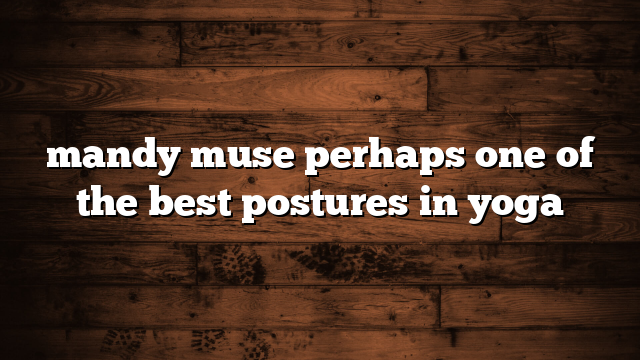Mandy Muse: Exploring One of the Best Postures in Yoga”
When practicing yoga, certain postures are more beneficial for improving flexibility, strength, and mental clarity. One such pose is Downward-Facing Dog (Adho Mukha Svanasana), which is often considered one of the most foundational and effective postures in yoga. Its ability to engage both the mind and body makes it a key part of many yoga routines. In fact, some may say it embodies the essence of yoga—balance, grounding, and mindfulness.
In this guide, we will explore why Downward-Facing Dog (or another similarly foundational yoga posture) may be considered one of the best, focusing on how to perform the pose correctly, its benefits, and how it integrates into an overall yoga practice.
Why is Downward-Facing Dog One of the Best Yoga Postures?
1. Full-Body Engagement
Downward-Facing Dog is a yoga posture that stretches and strengthens multiple parts of the body at once. It works the arms, shoulders, back, hamstrings, and calves while also building core strength. By engaging the whole body, it offers an excellent balance of flexibility and stability.
- How it Helps: This pose builds upper body strength while providing a deep stretch for the lower body. It’s an ideal posture for those seeking to improve overall flexibility and muscle tone.
2. Improves Circulation
Because the head is lower than the heart in this inverted posture, it encourages blood flow to the brain, promoting better circulation and increasing oxygen delivery to the brain. This provides an invigorating boost, helping with mental clarity and focus.
- Mental Benefits: The increase in blood flow can help reduce feelings of fatigue and increase alertness, making it perfect for starting or ending a yoga sequence.
3. Promotes Relaxation and Stress Relief
Downward-Facing Dog is often incorporated into vinyasa flows or used as a resting posture between more challenging poses. Holding this posture for several breaths helps to release tension, especially in the neck, shoulders, and back, which are common areas for stress to accumulate.
- How It Works: By elongating the spine and creating space between the vertebrae, this posture relieves compression and tension, contributing to an overall sense of calm and relaxation.
How to Perform Downward-Facing Dog Correctly
- Start on Hands and Knees: Begin in a tabletop position with your wrists aligned under your shoulders and your knees under your hips.
- Tuck Your Toes: Press into the mat with your toes and lift your hips towards the ceiling, straightening your legs.
- Align Your Spine: Focus on creating a long, straight line from your hands to your hips. Engage your core to prevent sagging in your lower back.
- Press into the Mat: Push evenly into your palms, spreading your fingers wide, and draw your shoulders away from your ears.
- Adjust Your Feet: Keep your feet hip-width apart, pressing your heels toward the mat (though they don’t need to touch the ground fully).
- Hold and Breathe: Stay in this position for 5-10 breaths, feeling the stretch and release in your body.
Benefits of Practicing Downward-Facing Dog
1. Strengthens the Upper Body
Regular practice of Downward-Facing Dog strengthens the muscles of the arms, shoulders, and chest. It’s a great way to build upper body endurance without using heavy weights, relying instead on your own body weight.
2. Stretches the Posterior Chain
The pose stretches the entire back of the body, particularly the hamstrings, calves, and lower back. If you have tight hamstrings or suffer from back pain, regularly practicing this pose can help lengthen these areas and relieve tension.
3. Prepares the Body for Advanced Poses
Downward-Facing Dog serves as a foundation for more challenging postures, including inversions like headstands or handstands. It helps build the strength and flexibility required for these more advanced poses.
Integrating Downward-Facing Dog into Your Yoga Practice
1. As a Warm-Up
In many yoga sequences, Downward-Facing Dog is used as a transitional posture that opens up the body before moving into deeper stretches or more complex poses. It’s a great way to prepare the body for movement.
2. During a Vinyasa Flow
Downward-Facing Dog is often used in vinyasa flows to connect various postures. Moving through this pose helps maintain a fluid and continuous motion, keeping the body engaged throughout the practice.
3. As a Resting Pose
For more intense practices, Downward-Facing Dog can also act as a resting pose where you can focus on deep breathing and mindfulness between challenging movements.
Conclusion: Why Downward-Facing Dog is One of the Best Yoga Postures
Downward-Facing Dog stands out as a foundational yoga posture for a reason: it engages the entire body, improves circulation, and helps alleviate stress and tension. By practicing this pose regularly, you can enhance your strength, flexibility, and mental focus, making it an essential part of any well-rounded yoga practice.
If you’re looking to deepen your yoga routine, mastering Downward-Facing Dog will set you on a path to better overall wellness and help you progress to more advanced postures with confidence.



